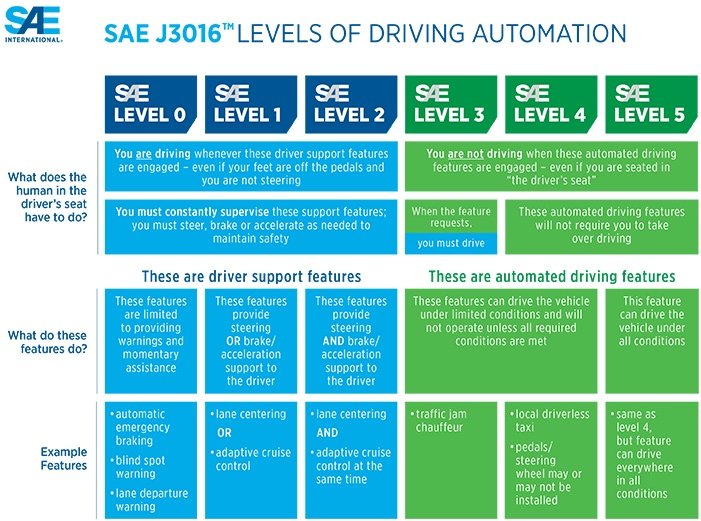www.auto-innovations.net
27
'23
Written on Modified on
Mouser News
Mouser on Vehicle Autonomy: What are the key stages?
Designing fully autonomous vehicles has been a goal of many automotive manufacturers for years. It is an ambition shared with national and international road safety organisations, too. However, as we are discovering in this series, designing an autonomous vehicle is far from easy.

There are many technology challenges to overcome, but there are also societal concerns about how artificial intelligence will prioritise human life. Removing the human from commanding a vehicle’s behaviour also raises legal complications for insurers, placing further accountability on algorithm developers and, ultimately, the vehicle manufacturer.
Despite the obstacles, progress towards vehicle autonomy is necessary. Our road networks are becoming more crowded, and, unfortunately, there is irrefutable evidence that the human driver continues to be the cause of most road traffic accidents. There is also another interesting aspect to self-driving cars, though, that is gathering momentum in society. Attitudes towards car ownership are changing, currently due in part to escalating fuel costs, but also because people are reconsidering the motives behind buying an expensive asset that will spend most of its time idle while still incurring maintenance, insurance, and road tax expenses. Mobility as a service (MaaS), where we can use a smartphone app to order an autonomous vehicle that will take us from A to B will, most likely, catch on quickly. The MaaS Alliance is already well established with a mix of public and partners to develop a sustainable and inclusive means of transportation around the globe.
Defining Vehicle Autonomy
To provide a framework for the development of autonomous vehicle systems, the Society of Automotive Engineers (SAE) has defined six levels of vehicle autonomy, starting from Level 0 through to Level 5. The first three levels, Level 0 (momentary assistance) to Level 2 (collaborative and integrated support), are already provided by most motor vehicle manufacturers in the form of advanced driver assistance systems (ADAS). ADAS functions primarily provide drivers with a level of support features that alert and guide them while driving. Popular ADAS features now available on most automotive platforms include adaptive cruise control (ACC), blind spot detection, lane departure/guidance (lane centring), adaptive lighting, emergency braking, and traffic sign recognition.
Top-end marques are likely to host a comprehensive set of ADAS features, while mid-priced vehicles may only include a limited set. The driver is still responsible for the steering and overall control of the vehicle, even though some ADAS features might appear capable of semi-autonomy. These supportive features are typically interdependent, employing sensors common to several functions. For example, the adaptive cruise control radar will also provide emergency braking functionality.
As vehicles advance towards Level 3, they become more integrated and capable of collaboration between the ADAS functions. However, the driver is still responsible for the safe command of the vehicle; even if their feet are not on the peddles, they must continue to be alert, supervise, and watch out for potential hazards and be ready to take over instantly.
From Driver Support to Autonomous Driving
From Level 3, the SAE specification assumes that vehicle autonomy occurs. For Level 3 itself, there is a blurred line with the caveat that if a self-driving system requests, the driver must take command. For Level 4 and Level 5, there is no requirement for a human driver, with peddles and a steering wheel becoming optional at the discretion of the vehicle manufacturer. The concept of a ‘driver’s seat’ is also removed; even if you are seated where the driver would normally sit, there is no provision for a human to take over. At Level 5, the vehicle can drive itself under all conditions. Level 3 and Level 4 stipulate that the autonomous vehicle’s systems can operate under specified conditions and that outside defined parameters the vehicle will not move.
Compared to the driver support functions up to Level 2 that many of us already have in our vehicles, the technology ‘step up’ from Level 3 to Level 5 is significant. The roadside communications infrastructure and standards required for full autonomy are still in their infancy, as is the collaboration between vehicle manufacturers. However, good progress in being achieved, with car manufacturer Mercedes Benz becoming the first manufacturer for a Level 3 Autopilot in their new model S-Class. Drivers are permitted to use the vehicle’s Autopilot feature on 13,191 kilometers of Germany roads in traffic jam situations and up to a speed of 60km/h. Other vehicle manufacturers and technology providers are working with automated transportation service companies to launch robot cabs in several countries.
This short blog has provided a short insight to the autonomous vehicle standards defined by the SAE. In the next blog, we investigate the essential sensor technologies required for self-driving cars to become a reality.
www.mouser.com

